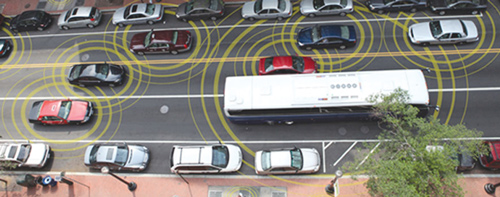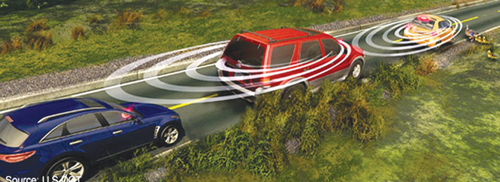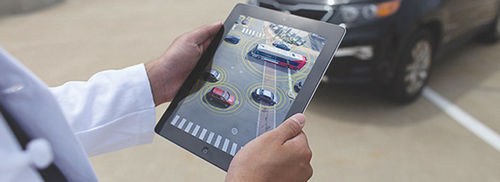|
||||||
The U.S. Department of Transportation is committed to improving safety and mobility on our nation’s roadways. As we look ahead to the next stage of roadway safety in America, connected vehicle technology shows great promise in transforming the way Americans travel. Through wireless technology, connected vehicles ranging from cars to trucks and buses to trains could one day be able to communicate important safety and mobility information to one another that helps save lives, prevent injuries, ease traffic congestion, and improve the environment.
The U.S. Department of Transportation is currently collaborating with some of the world’s largest automobile manufacturers to research how wireless technology can enable vehicles to communicate with each other and with the infrastructure around them. Connected vehicle technology, vehicle-to-vehicle and vehicle-to-infrastructure communications, could one day alert motorists of dangerous roadway conditions, impending collisions, or dangerous curves. Connected vehicles could also “talk” to traffic signals, work zones, toll booths, school zones, and other types of infrastructure. Connected vehicle systems are based on Dedicated Short Range Communications (DSRC), a technology similar to Wi-Fi which is fast, secure, reliable, and unlikely to be vulnerable to interference. Using either in-vehicle or after market devices that continuously share important safety and mobility information, vehicles ranging from cars to trucks and buses to trains would be able to “talk” to each other and to different types of roadway infrastructure.
Analyses by the U.S. Department of Transportation’s National Highway Traffic Safety Administration show connected vehicle technology could potentially address approximately 80 percent of the crash scenarios involving non-impaired drivers. Specifically, NHTSA research shows that this technology could help prevent the majority of types of crashes that typically occur in the real world such as crashes at intersections or while changing lanes.
According to the Texas Transportation Institute, American drivers spent 4.8 billion hours stuck in traffic in 2010 - the equivalent of nearly one full work week for every traveler on our roadways each year. Connected vehicle technology could enable drivers and transportation system operators to make smart choices to reduce travel delay.
According to the Texas Transportation Institute, the total amount of wasted fuel topped 3.9 billion gallons in 2009, the latest year that this data is available. Connected vehicle technology could give motorists the real time information they need to make “greener” transportation choices. Information about traffic conditions would help motorists eliminate unnecessary stops and let their vehicles reach optimal fuel efficiency.
Working together with the automotive industry, the U.S. Department of Transportation’s National Highway Traffic Safety Administration, Research and Innovative Technology Administration, and Federal Highway Administration, in coordination with other federal and state agencies, are conducting research to better understand how vehicle-to-vehicle and vehicle-to-infrastructure systems, that use connected vehicle (DSRC) technology, can improve safety and mobility and whether they could be effectively applied in the real world. Current research efforts are focused on vehicle-to-vehicle safety applications that would operate alongside and in concert with sensor based crash avoidance technologies that are already on the market and available to consumers. This research is being conducted through partnering agreements including the Vehicle Infrastructure Integration Consortium, University of Michigan Transportation Research Institute and the Crash Avoidance Metrics Partnership. Eight major automotive manufacturers are providing support for the Department’s research through partnering agreements: Ford Motor Company, General Motors LLC., Honda R&D Americas, Inc., Hyundai-Kia America Technical Center, Inc., Mercedes Benz Research and Development North America, Inc., Nissan Technical Center North America, Toyota Motor Engineering & Manufacturing North America, Inc. and Volkswagen Group of America, Inc.
The Safety Pilot program is a two phase, joint research initiative led by NHTSA and RITA to examine connected vehicle technology and real world applications. The Safety Pilot will lay the groundwork for understanding how this technology interacts in a real world setting between vehicles and between vehicles and the infrastructure. By evaluating connected vehicle technology, the Department expects to gather the information it needs to decide if these innovations are ready and effective enough to move forward with additional vehicle-to-vehicle communications programs including potential rulemaking activities.
In August 2011, the Department began its first phase of research through a series of driver acceptance clinics. Driver clinics were designed to obtain driver acceptance data in cars equipped with “vehicle-to-vehicle” safety systems. The driver assistance applications that were tested included in-car collision warnings, “do not pass” alerts, warnings that a vehicle ahead has stopped suddenly, and other similar safety messages. The six month program evaluated a total of approximately 700 drivers at the six driver clinics in Michigan, Minnesota, Florida, Virginia, California, and Texas and was completed in January 2012. The information gathered from the program showed that an overwhelming majority of drivers (9 out of 10) would like to have the vehicle-to-vehicle features included in their own vehicles and most believe the technology would be useful in improving driver safety. Dates and locations included:
On August 21, 2012, the U.S. Department of Transportation and its research partners launched the second part of the Safety Pilot with a model deployment to further test connected vehicle technology in a year long effort from summer 2012 through summer 2013. Supported by a diverse team of industry, public agencies, and academia, the model deployment will operate on roads in Ann Arbor, Michigan and test a limited number of vehicle-toinfrastructure safety applications in addition to continuing the research on vehicle-to-vehicle safety applications. The U.S. Department of Transportation contracted with the University of Michigan’s Transportation Research Institute to conduct the model deployment which will use connected vehicle technology in a real world environment and gather extensive data about system operability, effectiveness, and security. The test site will create a highly concentrated environment of vehicles “talking” to each other using approximately 3,000 vehicles (including cars, trucks, and buses) equipped with vehicle-to-vehicle communications devices. These vehicles will send and receive electronic data from other equipped vehicles at the site and translate the data into a warning to the driver if and when specific safety hazards occur. The devices that will be tested include systems that are directly embedded in the vehicle, as well as after market safety systems, and “simple” communications beacons that are brought into the vehicle. All systems and devices emit a basic safety message 10 times per second that forms the data stream that other in-vehicle devices use to determine when a potential traffic hazard exists. Combined with the vehicle’s own data, this information provides highly accurate data that is used by the crash avoidance safety applications. The Safety Pilot Model Deployment will obtain empirical test data for determining the technologies’ effectiveness at reducing crashes. These capabilities will also be extended to a limited set of applications in which vehicles will communicate with highway infrastructure or “vehicle-to-infrastructure”. The information collected from both phases of the Safety Pilot, along with the results of other key research projects being conducted in the connected vehicle program, will be used by NHTSA to determine by some time in 2013 whether to proceed with additional vehicle-to-vehicle communication activities including possible future rule makings.
© 2013 TLC Magazine Online, Inc. |
||||||




